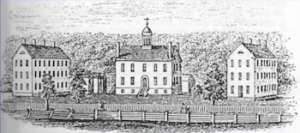
*The Oneida Institute opening is celebrated on this date in 1827. They were a short-lived (16 years) but highly influential school that was a national leader in the (then) emerging anti-slavery movement.
George Washington Gale founded it as the Oneida Institute of Science and Industry. His former teacher (in the Addison County Grammar School, Middlebury, John Frost, now a Presbyterian minister in Whitesboro with a wealthy wife and daughter of Thomas Ruggles Gold, was the primary partner in setting up the Institute. They raised $20,000, and with this, they bought land and began constructing the buildings. The Institute occupied "more than 100 acres bordered by Main Street and the Mohawk River and by Ellis and Ablett Avenues in Whitesboro village in New York.
The Institute opened with two instructors, Gale and Peletiah Rawson, the latter a Hamilton College graduate and engineer that had worked on the just-completed Erie Canal. Initially, 20 students, including most of the seven, worked in exchange for instruction on Gale's farm in Western New York, a pilot project. Theodore Weld, who would become the students' leader, was among them. Enrollment soon grew to 100; by 1830, 500 applicants had turned away for lack of space.
It was chartered in 1829 as the Oneida Institute of Science and Industry. Oneida was the first and leading American example of the manual labor college to supplement study with exercise's physical, spiritual, or psychological benefits. By "combining classical education with agricultural, horticultural, and mechanical labor," Gale also tried to make education more affordable. "Students worked on the farm, or in the carpenter, trunk and harness-making shops"; a printing shop was added later.
The first year, floods destroyed the crops. Still, in the second year, students produced fifty cords of wood, thirty barrels of cider, seven hundred bushels of corn, four hundred potatoes, one hundred of oats, twenty-five beans, thirty tons of hay, and eighty bushels of onions—the whole valued at $1000 [equivalent to $23,528 in 2018]. Studies were interrupted to hold protracted revival meetings." Gale replaced the study of Latin and Classical Greek with Hebrew and Biblical Greek. Oneida trained students "as emissaries of the new revivalism." "The result was a large crop of crusaders and reformers, who were later turned loose to fulminate against drink, slavery, Sabbath-breaking, [and] irreligion, some of whom became famous in their preaching fields." Gale "lacked the qualities of a leader." In the summer of 1832, a debate on colonization led to the formation of colonization and an anti-slavery society. Student dissatisfaction led to a mass walk-out in 1832, with about 24 students leaving for Lane, then Oberlin.
Replaced by Beriah Green, Gale left the Institute with "fiscal problems," saddled with "numerous financial obligations." Green accepted the job on two conditions: that he be allowed to preach "immediatism," the immediate emancipation of slaves, and that it be allowed to admit black students. These were agreed to. Before Green, there had not been any black students at Oneida; so far as is known, none had applied. The curriculum aligned with Green's goal of training abolitionist activists, which he believed was what Christianity mandated. Oneida and Whitestown Anti-Slavery Societies were soon formed, declaring that slavery was not just evil but a crime and a sin. In 1833, allowing Blacks into educational institutions alongside whites aroused bitter, even violent opposition. The Noyes Academy in New Hampshire was destroyed in 1835 after it admitted Blacks. Four of its students then enrolled at Oneida.
In New York, the American Colonization Society would not allow even a lecture series for Blacks on history. The Canterbury Female Boarding School was forced to close after it admitted one Black girl in 1832, and the school for "young ladies and little misses of color," which replaced it, was met with such escalating violence from the townspeople that director Prudence Crandall was forced to close it out of concern for the student's safety. New York Central College, called a "nigger college," was forced to close partly because of local hostility to the education of African Americans and even more so to black professors. A month before Green's arrival in August 1832, 35 students formed an antislavery society on immediatist principles, the first in New York State. Thirty-four students formed a colonization society; colonization was not in favor of full emancipation and thought the best place for free blacks was "back to Africa."
Green called for "immediate, unconditional, and uncompensated emancipation in his inaugural address." Oneida admitted black students, the first college in the country to do so without restrictions. There were generally 10–14 "colored students." In 1840, Native Americans were admitted increasing to 20. One of the first student movements in America, the Lane Rebels, began at Oneida. A contingent of about 24, with an acknowledged leader (Theodore Dwight Weld), left Oneida for Lane and, more publicly, soon left Lane for Oberlin. Oneida's first president, Gale, founded Knox Manual Labor Institute, later Knox College, in Galesburg, Illinois. Oneida hired its second president, Green, from Oberlin's competitor in northeast Ohio, Western Reserve College. All of this is linked to the explosively emerging focus on abolitionism.
The Oneida Institute closed in 1843. One factor was the New York Anti-Slavery Society's failure to pay the institute $2000 for the printing costs of their paper Friend of Man. According to Dana Bigelow, "Green left the institution a wreck." He identifies the causes of its failure as three: first, the manual labor scheme; "unskilled labor was found to be unprofitable." (The $1000 mentioned above did not cover costs.) Second, replacing the classics with the Bible; "this did much to disconnect the institution with the general theory and habit of culture in the country and to stamp it with a certain reputation of singularity which could not fail to be in many ways disastrous." Finally, the treating of black and white students equally, and its "iconoclastic zeal for the overthrow of social institutions and interests", led to "much popular odium."